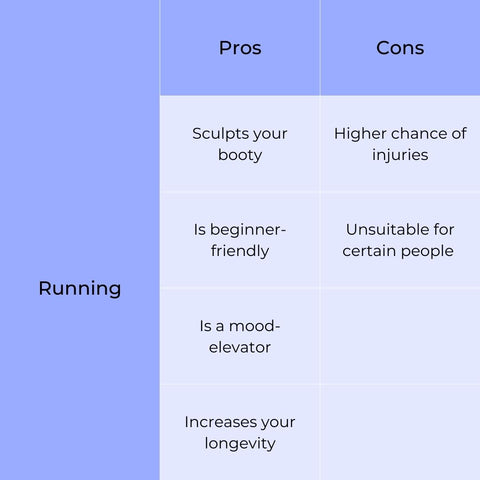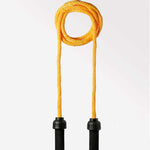Jump Rope vs Running - Which Is The Better Workout?

Jump rope vs running.
Both killer cardio workouts. Both serious calorie incinerators. Both super fun.
Jump rope and running also have a host of other benefits including improving your bone density, boosting your cardiovascular and mental health, relieving stress, and more.
So is skipping better than running or vice versa?
We’ll let you decide that one by showing you how skipping rope stacks up against running, in terms of the calories burned, muscles worked, impact on your joints, and more.
Let the battle of skipping vs running begin!
Jump rope vs running: Muscles worked
Both jumping rope and running score high on muscle engagement.
When you skip rope you don’t just activate your lower body muscles including your calves, quads, hamstrings, glutes, and obliques, but muscles also start firing in your entire upper body to control the force with which you twirl the rope. We’re talking abs, shoulders, forearms, biceps, triceps, chest, and back muscles!

Similarly, when you pound the pavement, you don’t just work your hip flexors, glutes, calves, etc. but also heavily engage your core which helps stabilize your whole body. Not to mention your biceps, triceps, lats, and deltoids that are used to pump your arms back and forth and propel you forward.
Winner: Tie
Jump rope vs running: Impact on joints
Here’s an eye-popping statistic.
In a recent study of around 200 recreational runners aged between 18 and 55, who had been running for at least a year, it was seen that 46% of them sustained injuries within a year, of which knee injuries accounted for 27%. The study also showed that newer runners tend to have higher injury incidence rates.
Running injuries usually occur due to factors such as poor form, overtraining, not enough rest between runs, running on hard surfaces such as concrete, etc.
Jumping rope can also put stress on your knees when you jump improperly, jump on a hard surface, jump too high, or don’t wear shock-absorbing shoes.
But as per a 2019 study, jumping rope puts a lot less stress on your knees as compared to running.
Winner: Jump rope
Jump rope vs running: Calories burned
Let’s get one thing straight. Skipping rope and running are both kick-ass calorie torchers.
But jumping rope does have a small advantage in that it can burn slightly more calories than running, when performed at a medium or high intensity.
Let’s look at the estimated number of calories burned in jumping rope vs running for a 150-pound person in 10 minutes.

Keep in mind that the number of calories you burn also depends on how good you are at either skipping rope or running.
Say you’re a fantastic runner who can run with excellent form but are completely hopeless with a jump rope, then you’re surely going to burn more calories running than skipping. But if you’re someone who can really work a jump rope, then there’s no better way to shed those calories.
Winner: Jump rope
You might also like: 12 Amazing Skipping Rope Exercises you have to try
Jump rope vs running: Fat loss
When you talk about running vs jump rope for fat loss, both of them are great ways to lose weight and melt body fat.

As per a study published in the European Journal of Applied Physiology, it was seen that jump rope exercise was an effective intervention to improve the risk factors of cardiovascular disease and reduce body fat.
Another recent study shows that running sprint-interval training is a time-efficient strategy for decreasing body fat while increasing fat-free mass in healthy individuals.
Winner: Tie
Jump rope vs running: Aerobic and Anaerobic benefits
Another commonality between skipping rope and running- They can be both aerobic and anaerobic exercises.
How?
When you jump rope at a slow pace or jog at a steady pace, it acts as an aerobic exercise - meaning your body uses oxygen to produce energy. Your breathing and heart rate increase for a sustained period and you’d be able to keep at it for a longer duration.
But when you skip rope at a high intensity or sprint, it becomes an anaerobic exercise where your body doesn’t use oxygen but instead uses energy from stored glycogen in your muscles. This means you’ll be able to perform at this fast-paced level only for a short time.
So what’s the big deal with working both your aerobic and anaerobic systems? Bigger and stronger muscles!
Aerobic exercises make use of your slow twitch muscle fibers (muscles that are responsible for endurance), while anaerobic exercises amp up the size and quantity of your fast twitch muscle fibers (muscles that help with those quick bursts of energy).
Just by switching up your jump rope intensity or running speed, you stand to gain both endurance and power.
Winner: Tie
Related: 10 Must-Do Jump Rope Workouts For Beginners
Jump rope vs running: Strength training benefit
Running is predominantly a cardio exercise. While you might build good muscle endurance in your legs, you will still need to supplement it with a strength-training routine.
But wait, isn’t jump rope also just cardio?
Not if your skipping rope is a weighted one!
With a weighted skipping rope, your forearms, shoulders, back, core, and upper arm muscles all go into overdrive because of the added resistance that it offers.
The result: Upper body strength to die for!
Winner: Jump rope
Want to know which type of skipping rope is best for you? Check out this blog post.
Jump rope vs running: Pros and Cons
Let’s take a look at the pros and cons of skipping rope vs running that’ll help you choose the one that is best suited for you.


Pros of jumping rope
Here are a few benefits of jumping rope vs running.
1. Burns calories efficiently
As mentioned earlier, when compared to running, jumping rope burns more calories in the same amount of time when done at a fast pace.
2. Is joint-friendly
When you jump rope with good form, your knees are bent and you land on the midsoles of your feet. Your knees and ankles thus turn into shock absorbers, meaning the force is evenly spread throughout your body with hardly any impact on your joints.
3. Gives you killer arms
A weighted skipping rope is all you need to get those drool-worthy shoulders, biceps, and triceps.
4. Needs less space
If you live in a teeny apartment or an area with weather conditions that make it impossible to run outside, then a jump rope is a no-brainer.
5. Amps up your running skills
Here’s a fun fact. You can actually get better at running by jumping rope.
How?
- It makes your runs smoother by reducing the amount of energy your body needs to expend to move at a faster speed.
- It helps strengthen your glutes – a crucial factor in helping runners hit top speed.
- It helps improve the coordination between your eyes, hands, and feet which can help with running.
So if you’re wondering whether skipping rope can be a good substitute for running, it definitely can.
You might like: 30-Minute Home Workout Routine And Tips For Beginners
Cons of jumping rope
1. Challenging for beginners
Skipping rope can be challenging as it can take a fair bit of time to get your rhythm and coordination down.
2. Unsuitable for certain people
Skipping rope is not recommended for people who
- Have recently suffered a heart attack or have heart problems such as ischemic heart disease or congestive heart failure.
- Have pre-existing medical conditions including knee injuries, or chronic joint pain particularly in the knees, ankles, and feet.
- Have asthma.
- Have high blood pressure.
- Have bone injuries.
- Have osteoporosis.
- Are recuperating after a major surgery or illness.
Pros of running
Check out these benefits of running vs skipping rope.
1. Sculpts your booty
If there’s one muscle group that’ll really thank you for running, it’s the glutes.
With distance running, the slow twitch muscle fibers in your glutes are fired up leading to a stronger and more toned booty.
Sprinting, on the other hand, uses your fast-twitch muscle fibers that cause an increase in muscle size. Translation: BIGGER BOOTY!
2. Is beginner-friendly
Running is easier for beginners as you don’t require too much coordination to get started.
3. Is a mood-elevator
Feelin’ blue? Running outdoors is one of the best mood boosters out there.
A 2011 study showed that folks who ran outdoors reported reduced feelings of depression, and higher energy levels.
Plus, let’s not forget all the Vitamin D you get to soak up that’ll do wonders for your eyes, bones, and immunity.
4. Increases your longevity
Research shows that “runners have a 25% to 40% reduced risk of premature mortality and live approximately three years longer than non-runners."
That’s one helluva reason to lace up those sneakers, right?
Cons of running
1. Higher chance of injuries
With running, there’s a higher risk of injuries to the knees and hips as most runners (especially marathoners) tend to heel strike (land on the heel first).
Running is not suitable for people who are obese, have joint alignment issues, or are arthritic. This is because such people are at a higher risk of damage to their weight-bearing joints during a run.
2. Unsuitable for certain people
Running is not recommended for people who:
- Have any type of cardiovascular disease
- Have respiratory problems
- Have disorders that increase the risk of falling
- Have conditions that affect mobility
- Are prone to joint, muscle, or bone injuries
Bottom line
You can’t go wrong when deciding between skipping vs running, since there are plenty of benefits to reap either way.
The important thing is to pick the activity that you enjoy doing the most. ‘Cause the best workout is the one that you consistently do.
If jump rope is your jam, then don’t forget to check out our awesome collection of skipping ropes.
In the skipping rope vs running duel, which one is the winner in your opinion? Tell us in the comments below!









Leave a comment